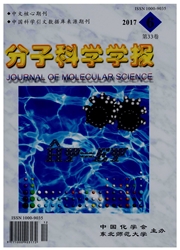

 中文摘要:
中文摘要:
对NaCl水溶液环境中,纤连蛋白(FNIII10)分子在金红石型TiO2(110)表面的吸附行为进行了分子动力学模拟.根据模拟溶液各成分与TiO2表面原子之间的径向分布函数、离子在水溶液中的扩散系数及FNIII10和离子的吸附构象等相关参数发现,分布于TiO2表面的稳定双层水分子是固液界面的主要特征,FNIII10分子通过天冬氨酸残基侧链末端的羧基基团(COO-)同表面Ti原子之间的强相互作用,结合赖氨酸残基侧链及位于FNIII10始端的精氨酸残基N端的氨基基团(NH3+)与表面桥氧原子之间的氢键作用,牢固地吸附在TiO2表面.溶液中吸附在TiO2表面的Na+可与羧基氧原子配合形成稳定的吸附构型,而分布在第二水层外侧的Cl-对纤连蛋白分子在TiO2(110)表面的吸附点位基本无影响.
 英文摘要:
英文摘要:
The adsorption behavior of fibronectin (FNIII10) on rutile TiO2 (110) surface in NaCl aqueous solution was studied by means of molecular dynamics simulation.The simulation results,including radial distribution function for components of the solution and atoms of the TiO2 surface,diffusion coefficients of ions in aqueous solution,adsorption conformations of FNIII10 and ions,suggest that two-layer water covering the surface steadily is the main character of the solid-liquid interface.FNIII10 maintains stable adsorption on TiO2 surface through strong interaction between carboxyl group locating at the side-chain ending of aspartic acid residue and surface Ti atoms,as well as hydrogen bonds of amino groups,which belong to the side-chain ending of lysine residue and N-terminal of arginine residue,with bridge oxygen atoms.The Na+ cations deposited on the TiO2 surface may associate themselves with carboxyl oxygen atoms to form stable adsorption configurations,while the Cl-anions repelled to the second water layer,have no influence on the adsorption of the fibronectin.
 同期刊论文项目
同期刊论文项目
 同项目期刊论文
同项目期刊论文
 期刊信息
期刊信息
